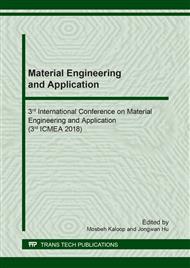p.110
p.115
p.120
p.126
p.131
p.137
p.144
p.150
p.155
Direct Tensile Strength of Lightweight Concrete Using Polypropylene Coarse Aggregate Coated with Sand
Abstract:
Plastic waste used as coarse aggregates in structural concrete is part of efforts to minimizeenvironmental pollution. It can provide lightweight concrete but with a lower strength compared tonormal concrete. Accordingly, an experimental study of 12 concrete specimens using wastepolypropylene coarse aggregates coated with sand was carried out. Direct tensile tests were conductedto cylinder concrete specimens having diameter of 10 cm and depth of 20 cm respectively. Threemixtures of sand coated polypropylene coarse plastic aggregate, river sand as fine aggregate, waterand Portland Composite Cement with a water-cement ratio of 0.286 were conducted. The massproportion of cement and sand are the same but the mass of plastic coarse aggregates coated withsand is specific for each mixture. Direct tensile strength of the specimens in general shows that highertensile strength is found for specimens having higher compressive strength. From the test results, amodel of direct tensile stress-strain relation is proposed. Finally the direct tensile strength forlightweight concrete using polypropylene coarse aggregate coated with sand is found to be lower thanthe direct tensile strength for normal concrete.
Info:
Periodical:
Pages:
131-136
Citation:
Online since:
November 2018
Authors:
Price:
Сopyright:
© 2018 Trans Tech Publications Ltd. All Rights Reserved
Share:
Citation:


